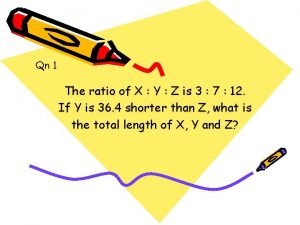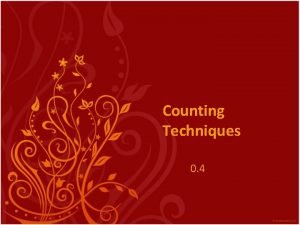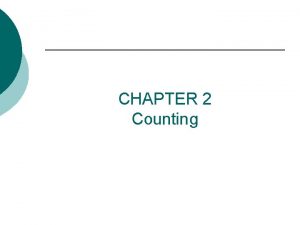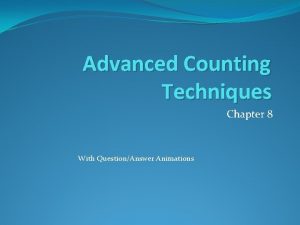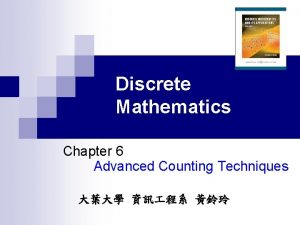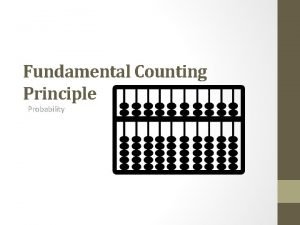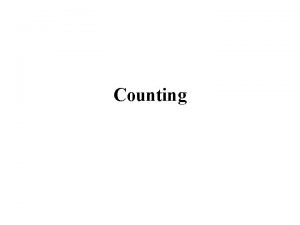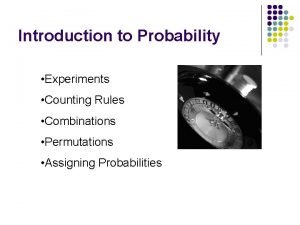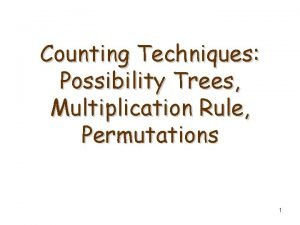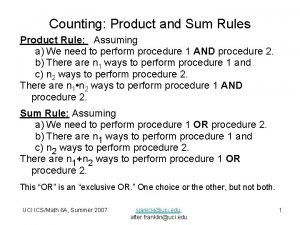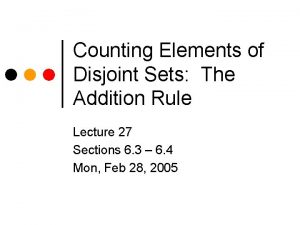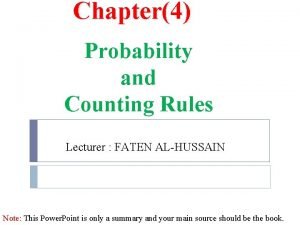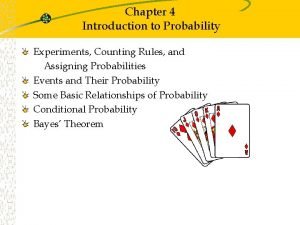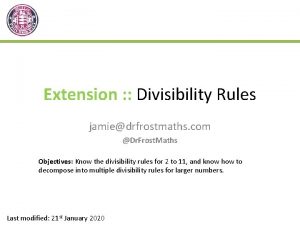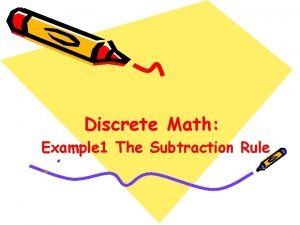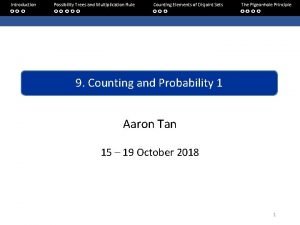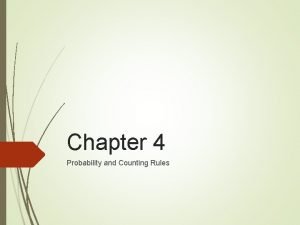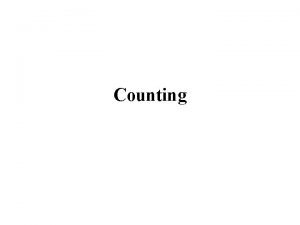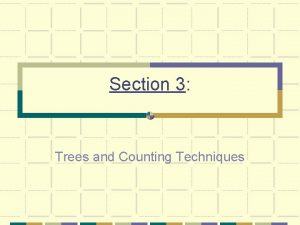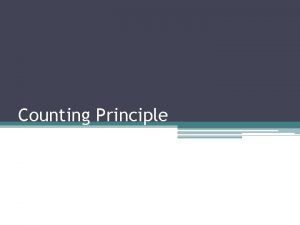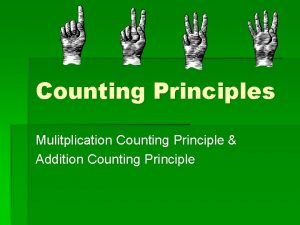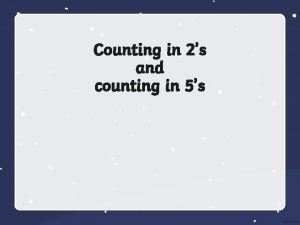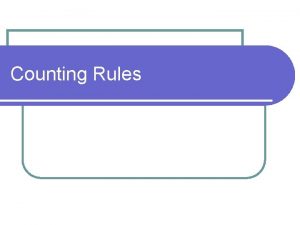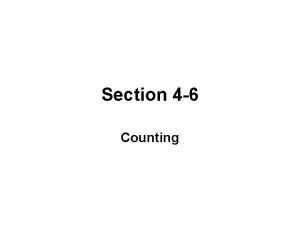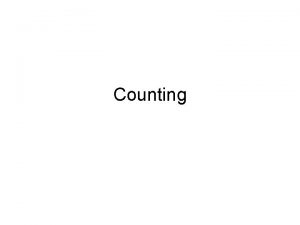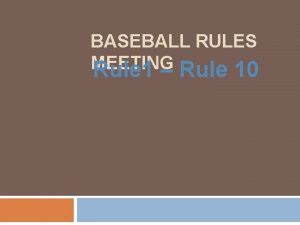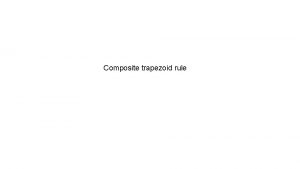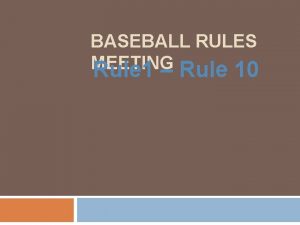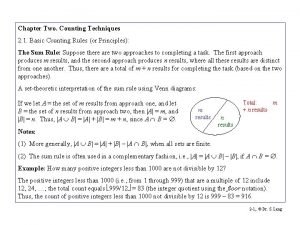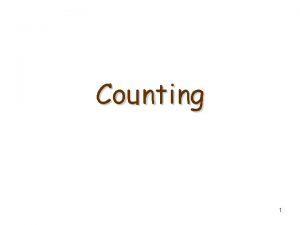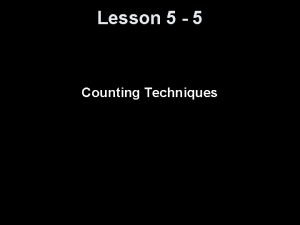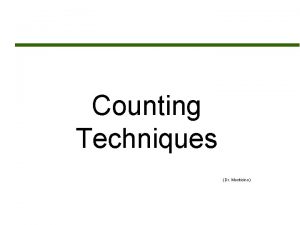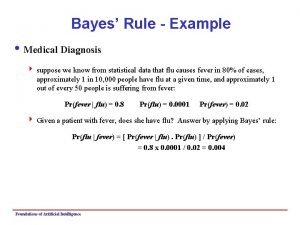Counting Techniques for counting Rule 1 Suppose we



















































- Slides: 51

Counting

Techniques for counting

Rule 1 Suppose we have a collection of sets A 1, A 2, A 3, … and that any pair are mutually exclusive (i. e. A 1 A 2 = f) Let ni = n (Ai) = the number of elements in Ai. Let A = A 1 A 2 A 3 …. Then N = n( A ) = the number of elements in A = n 1 + n 2 + n 3 + …

A 1 A 2 n 1 n 2 A 3 n 3 A 4 n 4

Rule 2 Suppose we carry out two operations in sequence Let n 1 = the number of ways the first operation can be performed n 2 = the number of ways the second operation can be performed once the first operation has been completed. Then N = n 1 n 2 = the number of ways the two operations can be performed in sequence.

Diagram:

Examples 1. We have a committee of 10 people. We choose from this committee, a chairman and a vice chairman. How may ways can this be done? Solution: Let n 1 = the number of ways the chairman can be chosen = 10. Let n 2 = the number of ways the vice-chairman can be chosen once the chair has been chosen = 9. Then N = n 1 n 2 = (10)(9) = 90

2. In Black Jack you are dealt 2 cards. What is the probability that you will be dealt a 21? Solution: The number of ways that two cards can be selected from a deck of 52 is N = (52)(51) = 2652. A “ 21” can occur if the first card is an ace and the second card is a face card or a ten {10, J, Q, K} or the first card is a face card or a ten and the second card is an ace. The number of such hands is (4)(16) +(16)(4) =128 Thus the probability of a “ 21” = 128/2652 = 32/663

Rule 3 Suppose we carry out k operations in sequence Let n 1 = the number of ways the first operation can be performed ni = the number of ways the ith operation can be performed once the first (i - 1) operations have been completed. i = 2, 3, … , k Then N = n 1 n 2 … nk = the number of ways the k operations can be performed in sequence.


Examples 1. Permutations: How many ways can you order n objects Solution: Ordering n objects is equivalent to performing n operations in sequence. 1. Choosing the first object in the sequence (n 1 = n) 2. Choosing the 2 nd object in the sequence (n 2 = n -1). … k. Choosing the kth object in the sequence (nk = n – k + 1) … n. Choosing the nth object in the sequence (nn = 1) The total number of ways this can be done is: N = n(n – 1)…(n – k + 1)…(3)(2)(1) = n!

Example How many ways can you order the 4 objects {A, B, C, D} Solution: N = 4! = 4(3)(2)(1) = 24 Here are the orderings. ABCD ABDC ACBD ACDB ADBC ADCB BACD BADC BCAD BCDA BDAC BDCA CABD CADB CBAD CBDA CDAB CDBA DABC DACB DBAC DBCA DCAB DCBA

Examples - continued 2. Permutations of size k (< n): How many ways can you choose k objects from n objects in a specific order Solution: This operation is equivalent to performing k operations in sequence. 1. Choosing the first object in the sequence (n 1 = n) 2. Choosing the 2 nd object in the sequence (n 2 = n -1). … k. Choosing the kth object in the sequence (nk = n – k + 1) The total number of ways this can be done is: N = n(n – 1)…(n – k + 1) = n!/ (n – k)! This number is denoted by the symbol

Definition: 0! = 1 This definition is consistent with for k = n

Example How many permutations of size 3 can be found in the group of 5 objects {A, B, C, D, E} Solution: ABC ABD ABE ACD ACE ADE BCD BCE BDE CDE ACB ADB AEB ADC AED BDC BED CED BAC BAD BAE CAD CAE DAE CBD CBE DCE BCA BDA BEA CDA CEA DEA CDB CEB DEC CAB DAB EAB DAC EAD DBC EBD ECD CAB DBA EBA DCA EDA DCB EDB EDC

Example We have a committee of n = 10 people and we want to choose a chairperson, a vice-chairperson and a treasurer Solution: Essentually we want to select 3 persons from the committee of 10 in a specific order. (Permutations of size 3 from a group of 10).

Example We have a committee of n = 10 people and we want to choose a chairperson, a vice-chairperson and a treasurer. Suppose that 6 of the members of the committee are male and 4 of the members are female. What is the probability that the three executives selected are all male? Solution: Again we want to select 3 persons from the committee of 10 in a specific order. (Permutations of size 3 from a group of 10). The total number of ways that this can be done is: This is the size, N = n(S), of the sample space S. Assume all outcomes in the sample space are equally likely. Let E be the event that all three executives are male

Hence Thus if all candidates are equally likely to be selected to any position on the executive then the probability of selecting an all male executive is:

Examples - continued 3. Combinations of size k ( ≤ n): A combination of size k chosen from n objects is a subset of size k where the order of selection is irrelevant. How many ways can you choose a combination of size k objects from n objects (order of selection is irrelevant) Here are the combinations of size 3 selected from the 5 objects {A, B, C, D, E} {A, B, C} {A, B, D} { A, B, E} {A, C, D} {A, C, E} {A, D, E} {B, C, D} {B, C, E} {B, D, E} {C, D, E}

Important Notes 1. In combinations ordering is irrelevant. Different orderings result in the same combination. 2. In permutations order is relevant. Different orderings result in the different permutations.

How many ways can you choose a combination of size k objects from n objects (order of selection is irrelevant) Solution: Let n 1 denote the number of combinations of size k. One can construct a permutation of size k by: 1. Choosing a combination of size k (n 1 = unknown) 2. Ordering the elements of the combination to form a permutation (n 2 = k!)

The number: is denoted by the symbol read “n choose k” It is the number of ways of choosing k objects from n objects (order of selection irrelevant). n. Ck is also called a binomial coefficient. It arises when we expand (x + y)n (the binomial theorem)

The Binomial theorem:

Proof: The term xkyn - k will arise when we select x from k of the factors of (x + y)n and select y from the remaining n – k factors. The no. of ways that this can be done is: Hence there will be terms equal to xkyn - k and

Pascal’s triangle – a procedure for calculating binomial coefficients 1 1 1 1 1 3 4 5 6 7 2 3 6 10 15 21 1 4 10 20 35 1 1 5 15 35 1 6 21 1 7 1

• The two edges of Pascal’s triangle contain 1’s • The interior entries are the sum of the two nearest entries in the row above • The entries in the nth row of Pascals triangle are the values of the binomial coefficients

Pascal’s triangle 1 1 1 1 1 3 4 5 6 7 2 3 6 10 15 21 1 4 10 20 35 1 1 5 15 35 1 6 21 1 7 1

The Binomial Theorem

Summary of counting results Rule 1 n(A 1 A 2 A 3 …. ) = n(A 1) + n(A 2) + n(A 3) + … if the sets A 1, A 2, A 3, … are pairwise mutually exclusive (i. e. Ai Aj = f) Rule 2 N = n 1 n 2 = the number of ways that two operations can be performed in sequence if n 1 = the number of ways the first operation can be performed n 2 = the number of ways the second operation can be performed once the first operation has been completed.

Rule 3 N = n 1 n 2 … nk = the number of ways the k operations can be performed in sequence if n 1 = the number of ways the first operation can be performed ni = the number of ways the ith operation can be performed once the first (i - 1) operations have been completed. i = 2, 3, … , k

Basic counting formulae 1. Orderings 2. Permutations The number of ways that you can choose k objects from n in a specific order 3. Combinations The number of ways that you can choose k objects from n (order of selection irrelevant)

Applications to some counting problems • The trick is to use the basic counting formulae together with the Rules • We will illustrate this with examples • Counting problems are not easy. The more practice better the techniques

Application to Lotto 6/49 Here you choose 6 numbers from the integers 1, 2, 3, …, 47, 48, 49. Six winning numbers are chosen together with a bonus number. How many choices for the 6 winning numbers

You can lose and win in several ways 1. 2. 3. 4. 5. 6. 7. 8. 9. No winning numbers – lose One winning number – lose Two winning numbers - lose Two + bonus – win $5. 00 Three winning numbers – win $10. 00 Four winning numbers – win approx. $80. 00 5 winning numbers – win approx. $2, 500. 00 5 winning numbers + bonus – win approx. $100, 000. 00 6 winning numbers – win approx. $4, 000. 00

Counting the possibilities 1. No winning numbers – lose All six of your numbers have to be chosen from the losing numbers and the bonus 1. One winning number – lose 2. Two winning numbers - lose 3. Two + bonus – win $5. 00 4. Three winning numbers – win $10. 00 5. Four winning numbers – win approx. $80. 00 6. 5 winning numbers – win approx. $2, 500. 00 7. 5 winning numbers + bonus – win approx. $100, 000. 00 8. 6 winning numbers – win approx. $4, 000. 00

Counting the possibilities 1. No winning numbers – lose All six of your numbers have to be chosen from the losing numbers and the bonus. 2. One winning numbers – lose One number is chosen from the six winning numbers and the remaining five have to be chosen from the losing numbers and the bonus.

3. Two winning numbers – lose Two numbers are chosen from the six winning numbers and the remaining four have to be chosen from the losing numbers (bonus not included) 4. Two winning numbers + the bonus – win $5. 00 Two numbers are chosen from the six winning numbers, the bonus number is chose and the remaining three have to be chosen from the losing numbers.

5. Three winning numbers – win $10. 00 Three numbers are chosen from the six winning numbers and the remaining three have to be chosen from the losing numbers + the bonus number 6. four winning numbers – win approx. $80. 00 Four numbers are chosen from the six winning numbers and the remaining two have to be chosen from the losing numbers + the bonus number

7. five winning numbers (no bonus) – win approx. $2, 500. 00 Five numbers are chosen from the six winning numbers and the remaining number has to be chosen from the losing numbers (excluding the bonus number) 8. five winning numbers + bonus – win approx. $100, 000. 00 Five numbers are chosen from the six winning numbers and the remaining number is chosen to be the bonus number

9. six winning numbers (no bonus) – win approx. $4, 000. 00 Six numbers are chosen from the six winning numbers,

Summary

Another Example counting poker hands A poker hand consists of five cards chosen at random from a deck of 52 cards. The total number of poker hands is

Types of poker hand counting poker hands 1. Nothing Hand {x, y, z, u, v} • Not all in sequence or not all the same suit 2. Pair {x, x, y, z, u} 3. Two pair {x, x, y, y, z} 4. Three of a kind {x, x, x, y, z} 5. Straight {x, x+ 1, x + 2, x + 3, x + 4} • • 6. 5 cards in sequence Not all the same suit Flush {x, y, z, u, v} • Not all in sequence but all the same suit

7. Full House {x, x, x, y, y} 8. Four of a kind {x, x, y} 9. Straight Flush {x, x+ 1, x + 2, x + 3, x + 4} • • 5 cards in sequence but not {10, J, Q, K, A} all the same suit 10. Royal Flush {10, J, Q, K, A} • all the same suit

counting the hands 2. Pair {x, x, y, z, u} We have to: • • Choose the value of x Select the suits for the for x. Choose the denominations {y, z, u} Choose the suits for {y, z, u} - 4× 4× 4 = 64 Total # of hands of this type = 13 × 6 × 220 × 64 = 1, 098, 240 3. Two pair {x, x, y, y, z} We have to: • • Choose the values of x, y Select the suits for the for x and y. Choose the denomination z Choose the suit for z - 4 Total # of hands of this type = 78 × 36 × 11 × 4 = 123, 552

4. Three of a kind {x, x, x, y, z} We have to: • • Choose the value of x Select the suits for the for x. Choose the denominations {y, z} Choose the suits for {y, z} - 4× 4 = 16 Total # of hands of this type = 13 × 4 × 66 × 16 = 54, 912 7. Full House {x, x, x, y, y} We have to: • Choose the value of x then y • Select the suits for the for x. • Select the suits for the for y. Total # of hands of this type = 156 × 4 × 6 = 3, 696

8. Four of a kind {x, x, y} We have to: • • Choose the value of x Select the suits for the for x. Choose the denomination of y. Choose the suit for y - 4 Total # of hands of this type = 13 × 12 × 4 = 624 10. Royal Flush {10, J, Q, K, A} • all the same suit Total # of hands of this type = 4 (no. of suits) 9. Straight Flush {x, x+ 1, x + 2, x + 3, x + 4} • • 5 cards in sequence but not {10, J, Q, K, A} all the same suit Total # of hands of this type = 9× 4 = 36 (no. of suits) The hand could start with {A, 2, 3, 4, 5, 6, 7, 8, 9}

5. Straight {x, x+ 1, x + 2, x + 3, x + 4} • • 5 cards in sequence Not all the same suit We have to: • Choose the starting value of the sequence, x. Total of 10 possibilities {A, 2, 3, 4, 5, 6, 7, 8, 9, 10} • Choose the suit for each card 4 × 4 × 4 = 1024 Total # of hands of this type = 1024 × 10 - 36 - 4 = 10200 We would have also counted straight flushes and royal flushes that have to be removed

6. Flush {x, y, z, u, v} • Not all in sequence but all the same suit We have to: • Choose the suit 4 choices • Choose the denominations {x, y, z, u, v} Total # of hands of this type = 1287 × 4 - 36 - 4 = 5108 We would have also counted straight flushes and royal flushes that have to be removed

Summary

Next Topic: Probability Rules
 Qn-1
Qn-1 Discrete probability and advanced counting techniques
Discrete probability and advanced counting techniques Counting techniques in probability
Counting techniques in probability Counting techniques examples
Counting techniques examples Advanced counting techniques
Advanced counting techniques Advanced counting techniques
Advanced counting techniques Using tree diagram
Using tree diagram Counting techniques examples
Counting techniques examples Counting rule for permutations
Counting rule for permutations Counting multiplication rule
Counting multiplication rule Product sum rule
Product sum rule Addition rule of counting
Addition rule of counting Symbolic probability rules
Symbolic probability rules Counting rule for multiple-step experiments
Counting rule for multiple-step experiments Dr frost math
Dr frost math Product rule discrete math
Product rule discrete math Possibility trees and the multiplication rule
Possibility trees and the multiplication rule Product and sum rule
Product and sum rule Chapter 4 probability and counting rules
Chapter 4 probability and counting rules Fonctions et solutions techniques
Fonctions et solutions techniques Iso 22301 utbildning
Iso 22301 utbildning Typiska novell drag
Typiska novell drag Tack för att ni lyssnade bild
Tack för att ni lyssnade bild Vad står k.r.å.k.a.n för
Vad står k.r.å.k.a.n för Varför kallas perioden 1918-1939 för mellankrigstiden?
Varför kallas perioden 1918-1939 för mellankrigstiden? En lathund för arbete med kontinuitetshantering
En lathund för arbete med kontinuitetshantering Personalliggare bygg undantag
Personalliggare bygg undantag Vilotidsbok
Vilotidsbok Sura för anatom
Sura för anatom Densitet vatten
Densitet vatten Datorkunskap för nybörjare
Datorkunskap för nybörjare Tack för att ni lyssnade bild
Tack för att ni lyssnade bild Att skriva debattartikel
Att skriva debattartikel Magnetsjukhus
Magnetsjukhus Nyckelkompetenser för livslångt lärande
Nyckelkompetenser för livslångt lärande Påbyggnader för flakfordon
Påbyggnader för flakfordon Vätsketryck formel
Vätsketryck formel Svenskt ramverk för digital samverkan
Svenskt ramverk för digital samverkan Lyckans minut erik lindorm analys
Lyckans minut erik lindorm analys Presentera för publik crossboss
Presentera för publik crossboss Argument för teckenspråk som minoritetsspråk
Argument för teckenspråk som minoritetsspråk Bat mitza
Bat mitza Klassificeringsstruktur för kommunala verksamheter
Klassificeringsstruktur för kommunala verksamheter Epiteltyper
Epiteltyper Claes martinsson
Claes martinsson Centrum för kunskap och säkerhet
Centrum för kunskap och säkerhet Lågenergihus nyproduktion
Lågenergihus nyproduktion Bra mat för unga idrottare
Bra mat för unga idrottare Verktyg för automatisering av utbetalningar
Verktyg för automatisering av utbetalningar Rutin för avvikelsehantering
Rutin för avvikelsehantering Smärtskolan kunskap för livet
Smärtskolan kunskap för livet Ministerstyre för och nackdelar
Ministerstyre för och nackdelar
